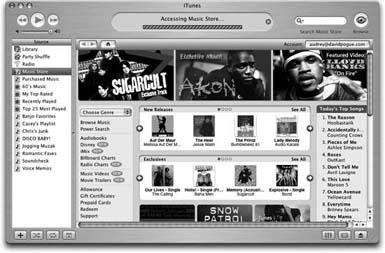The recent explosion in Internet song swapping presented the recording industry with a paradoxical challenge: to stop music lovers from freely trading files over the Internet, while trying to make money themselves by selling copy-protected music online. The early attempts, backed by the major record companies, featured a monthly fee, a puny song catalog, and no ability to burn the bought music to CDs or save it onto music players. What a deal!
Needless to say, people stayed away in droves. The free (and free-form) world of KaZaA, LimeWire, and similar file-trading services were much more attractive.
Then Apple took a whack at it. In April 2003, the iTunes Music Store debuted, an online component of iTunes that scored the hat trick that other companies had yet to achieve: digital audio downloads that were easy, cheap, and—drum roll, please—legal. Here’s a look inside the store, and how to shop it.
The iTunes Music Store has the backing (and the song catalogs) of five big music companies, plus an increasing number of independent ones. Its inventory contains over a million songs from major-label artists like Bob Dylan, U2, Missy Elliott, Jewel, Sting, and hundreds of other musicians in a range of popular styles like Rock, Pop, R & B, Jazz, Folk, Rap, Latin, Classical, and more—and the collection grows by thousands of songs a week. You can also browse, sample, or buy any of 5,000 audiobooks from Audible.com.
Tip
To see what songs have been added recently, click the Just Added link at the left side of the main Music Store page.
Farther down the page, you can also see and hear what famous people are listening to in the store’s Celebrity Playlist section. It never hurts to know what Wynton Marsalis and Kevin Bacon are listening to these days.
You can browse the virtual CD racks from the comfort of your own computer, listen to the first 30 seconds free from any track in the store, and download desired songs for 99 cents each with a click of the mouse. There are no monthly fees. And your digitally protected downloads don’t go poof! into the ether if you decide to cancel your subscription, as they do with certain rival services. All your downloaded songs go right into iTunes, where they are just a sync away from your iPod’s traveling music collection.
You can play the downloaded songs on up to five different iTunes 4–equipped Macs or PCs (in any combination), burn them onto an unlimited number of CDs, and download them to as many iPods as you like. Thousands of people use the Music Store every day, in fact, without even realizing that the songs are copy protected.
Apple’s success with the iTunes Music Store—over 100 million downloads by mid-2004—caught its rivals’ attention. These days, Apple’s imitators in the dollar-a-song biz include Napster 2.0, MusicMatch, Sony, and even Wal-Mart. (Remember, though, that music from these services come in Microsoft’s Windows Media Audio format, which won’t work on the iPod. Except Sony’s music service, which uses its own proprietary file format—but that doesn’t play on the iPod, either.)
Figure 4-1. The Browse button and Search box in the iTunes window perform their song-locating duties on the Store’s inventory. Each listing in the Choose Genre pop-up menu has its own set of pages.Below it, you can see a lot of the latest Music Store bells and whistles: movie trailers, radio charts, etc.
In the summer of 2004, Real Networks announced that the songs on its own Rhapsody music-download service were now iPod-playable, meaning that the company somehow reverse-engineered Apple’s song file format. Apple wasted no time in announcing that (a) it was furious, and (b) it would simply change the iPod’s software so that songs from non-Apple music stores would once again stop working.
Get iLife '04: The Missing Manual now with the O’Reilly learning platform.
O’Reilly members experience books, live events, courses curated by job role, and more from O’Reilly and nearly 200 top publishers.


